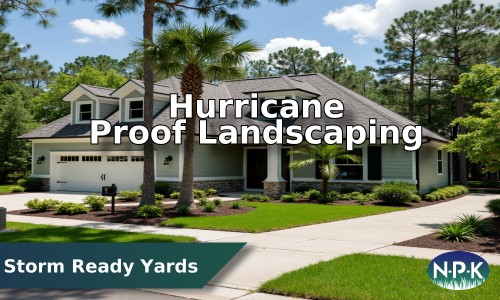
In coastal areas like Myrtle Beach, your landscaping does more than boost curb appeal; it plays a vital role in protecting your home from extreme weather. With hurricanes growing stronger and wetter, your yard becomes the first line of defense. Thoughtful plant choices, layout, and material selection can drastically reduce storm-related damage.
The National Oceanic and Atmospheric Administration (NOAA) reports a measurable increase in hurricane severity, with today’s storms producing 15% more rainfall, storm surges rising 2–3 feet higher, and stronger Category 4–5 wind events becoming more frequent. This means your landscape could either shield your home or become a source of flying debris and flood hazards.
Mature trees add shade and beauty to any yard, but during a storm, they can become dangerous. Research from UF/IFAS environmental horticulture expert Andrew Koeser found that many trees can survive weaker hurricanes. Still, wind gusts nearing 100 mph are enough to break limbs and uproot trees, especially those with shallow roots.
Pro tip: If you have large trees near your home, consult a certified arborist for safe pruning or removal.
Not all trees perform equally in a storm. Survivors grow slowly, with strong central trunks and anchoring roots. Avoid species that are brittle or top-heavy.
Prune trees regularly to maintain structure and prevent breakage. Avoid fast-growing, shallow-rooted varieties near your home.
Clusters of trees help break the wind and support one another. Avoid planting in straight lines; stagger them instead. For best results, plant trees within 10 feet of each other in groups of five or more using varied species for added stability.
Annual pruning reduces the risk of broken limbs and debris. A well-pruned tree is 73% more likely to survive a storm, according to the University of Florida. Remove weak or crowded branches and shape the canopy to let wind pass through.
Salt spray and storm surges can be deadly for sensitive plants. Coastal natives have evolved to tolerate these harsh conditions.
Solid fences act like sails in high winds and are prone to failure. Choose designs that let wind pass through. Best coastal options include:
Reinforce posts with deep concrete footings and metal hardware. Avoid solid wood or vinyl privacy fences in areas prone to hurricanes.
Loose gravel and bark can become airborne hazards. Instead, use:
Avoid gravel near walkways and structures. These softer options still retain moisture and reduce erosion without becoming dangerous during storms.
Standing water causes long-term damage. Ensure proper grading, and consider adding:
A 5% slope away from your home is ideal to keep water from collecting near the foundation.
For Myrtle Beach residents, hurricane-resilient landscaping is essential. From plant choices to drainage design and storm-ready fencing, investing in the right landscape features now can prevent expensive repairs later. Hire a local pro who understands the region’s unique challenges and build a yard that’s ready to weather the next big storm.
NPK Lawn Care provides top-notch service delivered by trained and licensed technicians, all while prioritizing environmental responsibility.